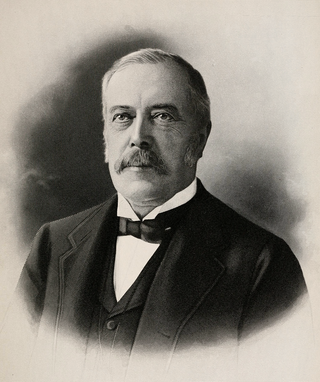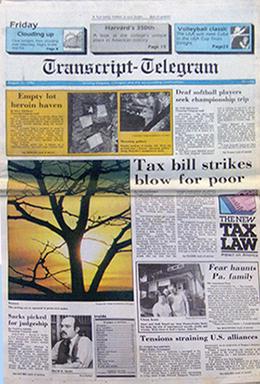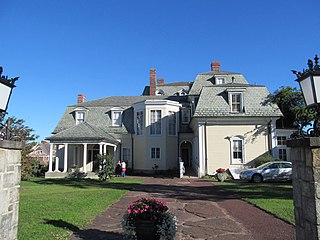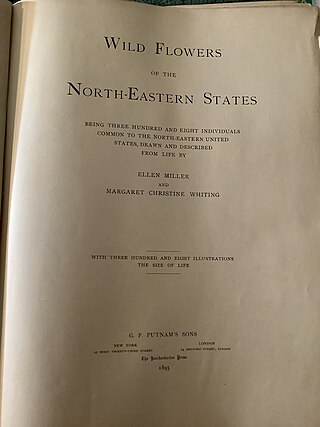
Holyoke is a city in Hampden County, Massachusetts, United States, that lies between the western bank of the Connecticut River and the Mount Tom Range. As of the 2020 census, the city had a population of 38,247. Located 8 miles (13 km) north of Springfield, Holyoke is part of the Springfield Metropolitan Area, one of the two distinct metropolitan areas in Massachusetts.

William Fairfield Whiting was United States secretary of commerce from August 22, 1928, to March 4, 1929, during the last months of the administration of Calvin Coolidge.

William Whiting was an American businessman and politician from Holyoke, Massachusetts. Whiting descended from an English family who first settled in Lynn, Massachusetts, during 1636.

The Holyoke Transcript-Telegram, or T‑T, was an afternoon daily newspaper covering the city of Holyoke, Massachusetts, United States, and adjacent portions of Hampden County and Hampshire County.

Wistariahurst is a historic house museum and the former estate of the Skinner family, located at 238 Cabot Street in Holyoke, Massachusetts. It was built in 1868 for William Skinner, the owner of a successful silk spinning and textile business, and is named for the abundant wisteria vines which cascade across its eastern facade. Originally constructed in Williamsburg in 1868, the mansion designed by Northampton architect William Ferro Pratt was moved to Holyoke in 1874, following the devastating flood which swept away the original Skinner mills. Following the death of Belle Skinner, its music room was operated as a private museum from 1930 to 1959, housing the Belle Skinner Collection of Old Musical Instruments, before their donation by the family to Yale University. Since 1959 it has been operated as the Wistariahurst Museum, and is open to the public. The property was listed on the National Register of Historic Places in 1973.

Elmwood is a neighborhood in Holyoke, Massachusetts located to the south of the city center, approximately 1 mile (1.6 km) from downtown. Elmwood is historically Holyoke's oldest village; predating the construction of the Hadley Falls Dam, it originated as part of the 3rd parish of West Springfield, and originally was known as Baptist Village as Holyoke's first and oldest congregation is the First Baptist Church, formally established in 1803, but maintaining a meetinghouse since 1792. Today the neighborhood contains many historic Victorian houses and about 510 acres (210 ha) of mixed residential and commercial zoning, as well as Holyoke High School, William R. Peck Middle School, Fitzpatrick Ice Skating Rink, and Mackenzie Stadium.

George Clinton Ewing was a salesman, wainwright, land agent, superintendent, assessor, selectman, state representative, and most notably one of the chief founders of Holyoke, Massachusetts; he is credited as having first brought the idea of building a dam and industrial city at Hadley Falls to investors in Boston, New York, Hartford, and St. Johnsbury, Vermont in 1846.

Roswell Parsons Crafts was an American businessman, politician, fire chief, and the second and sixth mayor of Holyoke, Massachusetts. Born in Whately, Massachusetts, to Chester and Phila Crafts, he arrived in Holyoke at age 11, and after attending school began his first business driving a stagecoach between Springfield and Northampton carrying mail and passengers. At the age of 20 he helped his brother, Chester, open a general store under the name Chester Crafts & Co. In 1843 he married Ms. Delia Jones of Ireland Parish; the couple bore one son, Pliny Jones Chester on February 9, 1845.

Ingleside is a neighborhood in Holyoke, Massachusetts located to the south of the city center, approximately 2 miles from downtown. The neighborhood features access to the Connecticut River through the Sue Ellen Panitch River Center and the Land of Providence reservation. Ingleside is also home to the Holyoke Mall, the Nuestras Raices farm, the Sisters of Providence of Holyoke, the Providence Behavioral Health Hospital, and several recreational and historical venues.

James Amasa Clough, often referred to as James A. Clough or J. A. Clough, was an American architect, carpenter, and contractor, who was active in New England, especially prominent in Western Massachusetts, and whose work shaped much of the architectural landscape of Holyoke during the late 19th and early 20th centuries. He would design several commercial blocks and public buildings there, such as the Holyoke Public Library, Canoe Club and the Mount Tom Summit House. The principal architect of the firm Clough & Reid, much of his work appeared under this name after 1890, when he made William B. Reid a partner- Reid having spent several years prior as Clough's draftsman. He remained principal of this firm until his retirement in 1907. One of Clough's other protégés, George P. B. Alderman, went on to establish his own architectural firm.


Springdale is a neighborhood in Holyoke, Massachusetts located to the south of the city center, approximately 1 mile (1.6 km) from downtown, on the banks of the Connecticut River. The neighborhood features Springdale Park, originally known as Riverside Park, which was designed by the influential Olmsted Brothers landscape architecture firm, as well as light industry and machine shops, residential housing, and the central supply warehouse of Holyoke Public Schools. The mixed zoning neighborhood was developed as a streetcar suburb by brickmaker John J. Prew, who gave the area its name and devised the first street plans and building lots for the area in 1887 as housing for millworkers of South Holyoke. Since 1984, Springdale Park has hosted the city's annual Western Massachusetts Puerto Rican Parade, a three-day annual event in June celebrating the city's Latin culture and music.

Oakdale is a neighborhood in Holyoke, Massachusetts located to the west of the city center, adjacent to downtown. Developed as a streetcar suburb in the late nineteenth century, today the neighborhood contains many Victorian houses, and about 460 acres (190 ha) of mixed residential and commercial zoning, as well as Forestdale Cemetery, Saint Jerome Cemetery, Rohan Park, and Holyoke Medical Center.

This is a bibliography of Holyoke, a city in Massachusetts, with books about the area's history, culture, geography, and people. Due to the area's proximity to a number of industrial developments and the numerous cultures of different waves of immigrant workers, a wide number of books, dissertations, and comprehensive articles have been written about Holyoke throughout its history in several languages. This list is not intended to be complete, authoritative, or exhaustive and does not include promotional material, travel guides, recipe books, directories, or the catalogs of industrial companies that have resided therein.

During the late 19th and early 20th centuries Holyoke saw an influx of Franco-Americans, predominantly French-Canadians, who immigrated to Massachusetts to work in the city's growing textile and paper mills. By 1900, 1 in 3 people in Holyoke were of French-Canadian descent, and a 1913 survey of French Americans in the United States found Holyoke, along with other Massachusetts cities, to have a larger community of French or French-Canadian born residents than those of New Orleans or Chicago at that time. Initially faced with discrimination for the use of their labor by mill owners to undermine unionization, as well as for their creation of separate French institutions as part of the La Survivance movement, this demographic quickly gained representation in the city's development and civic institutions. Holyoke was at one time a cultural hub for French-Canadian Americans; the Saint-Jean-Baptiste Society of America was first organized in the city in 1899, along with a number of other institutions, including theater and drama societies from which famed vaudevillian Eva Tanguay was first discovered, and regular publications, with its largest French weekly newspaper, La Justice, published from 1904 to 1964. The city was also home to author Jacques Ducharme, whose 1943 book The Shadows of the Trees, published by Harper, was one of the first non-fiction English accounts of New England's French and French-Canadian diaspora.
This is a timeline of the history of the city of Holyoke, Massachusetts, USA.

From the beginning of the city's history as the western bank of Springfield, Irish families have resided in and contributed to the development of the civics and culture of Holyoke, Massachusetts. Among the first appellations given to the city were the handles "Ireland", "Ireland Parish", or "Ireland Depot", after the village was designated the 3rd Parish of West Springfield in 1786. Initially occupied by a mixture of Yankee English and Irish Protestant families, many of whom belonged to the Baptist community of Elmwood, from 1840 through 1870 the area saw a large influx of Irish Catholic workers, immigrants to the United States, initially from the exodus of the Great Famine. During that period Irish immigrants and their descendants comprised the largest demographic in Holyoke and built much of the early city's infrastructure, including the dams, canals, and factories. Facing early hardships from Anti-Irish sentiment, Holyoke's Irish would largely build the early labor movement of the city's textile and paper mills, and remained active in the national Irish nationalist and Gaelic revival movements of the United States, with the Holyoke Philo-Celtic Society being one of 13 signatory organizations creating the Gaelic League of America, an early 20th century American counterpart of Conradh na Gaeilge.
As of the 2010 United States Census, there were 39,880 people, 15,361 households, and 9,329 families residing in the city of Holyoke, Massachusetts. The population density was 723.6/km2 (1,874/mi²). There were 16,384 housing units at an average density of 277.2/km2 (718.6/mi²).

Margaret C. Whiting (1860-1946), was born in Chester, Massachusetts but lived much of her adult life in Deerfield, Massachusetts. She trained as an artist, and published an illustrated book with Ellen Miller on wild flowers. She ad Miller co-founded the Deerfield Society of Blue and White Needlework, where she contributed her skills as a designer and teacher, and provided leadership for the organization. She won a gold medal for her needlework from the 1915 Worlds Fair in San Francisco for its design and color.























